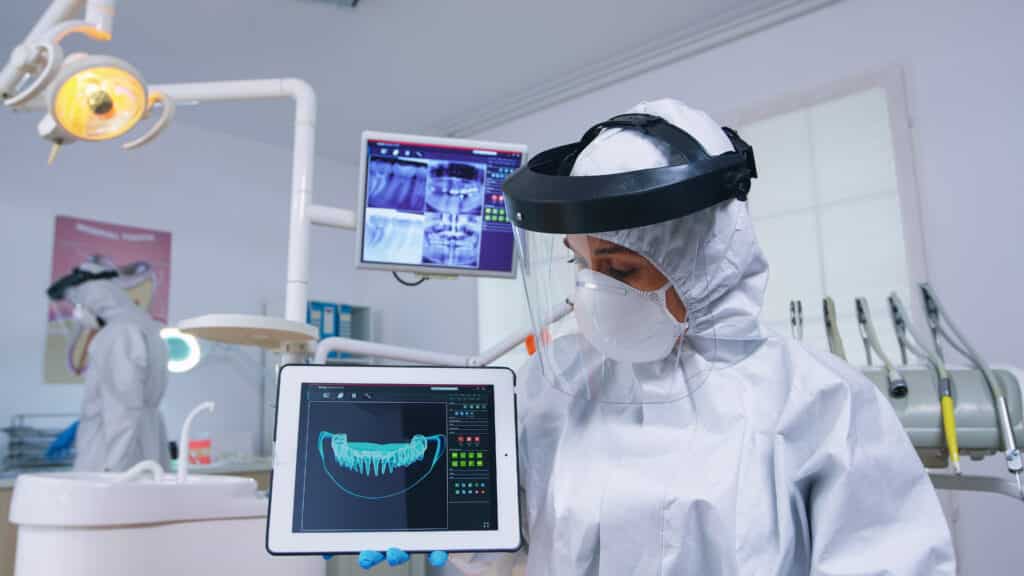In today’s rapidly advancing world, technology in modern dentistry is revolutionizing the way we care for our teeth and gums. From innovative imaging techniques to personalized treatment plans, technology is reshaping oral health care, making it more precise, efficient, and accessible. Modern dental practices now embrace tools like artificial intelligence, 3D printing, and virtual reality, enhancing patient experiences and treatment outcomes.
This article explores the remarkable advancements in dental technology, the benefits they bring to both patients and practitioners and what the future holds for oral health care.
Benefits of Technology in Modern Dentistry
1. Enhanced Diagnostics with Advanced Imaging
One of the most significant advancements in modern dentistry is the introduction of technologies like Cone Beam Computed Tomography (CBCT). This imaging tool provides highly detailed 3D views of oral structures, enabling dentists to diagnose issues more accurately than traditional X-rays. With improved diagnostics, treatment plans are more targeted, ensuring better outcomes for patients.
2. Faster and Precise Treatments
Dental lasers are another technological breakthrough, allowing for quicker and more precise procedures. Tasks like cavity detection, gum contouring, and teeth whitening are now faster and often require no anesthesia. This results in a more comfortable experience for patients and a reduced risk of infection.
3. Improved Accessibility with Teledentistry
Teledentistry has emerged as a game-changer, particularly for those in remote areas or with mobility challenges. By leveraging video conferencing and digital platforms, patients can consult with dentists from the comfort of their homes. This approach reduces the need for physical visits and expands access to quality oral care.
Innovative Technologies Shaping Dentistry
1. Digital Dentistry
Digital dentistry encompasses tools like CAD/CAM systems, intraoral scanners, and digital impressions. These technologies eliminate the discomfort of traditional molds and enable the creation of highly accurate dental restorations such as crowns and bridges. Same-day solutions are now possible, enhancing efficiency and patient satisfaction.
2. Artificial Intelligence (AI)
AI is revolutionizing diagnostics and treatment planning. By analyzing extensive patient data, AI helps dentists create personalized care strategies. AI-powered chatbots and tools also improve patient communication, answering common oral health questions and providing tailored advice in real-time.
3. Virtual Reality (VR)
Virtual reality is transforming patient experiences by easing dental anxiety. Patients can immerse themselves in relaxing virtual environments during treatments or explore simulations of dental procedures. VR is also used in education, helping patients visualize the impact of treatments on their oral health.
4. 3D Printing
3D printing technology enables the production of dental prosthetics, surgical guides, and orthodontic aligners with remarkable precision. In-house fabrication reduces costs and turnaround times, making treatments more efficient and affordable.
The Role of Mobile Apps in Oral Health Management
Mobile applications are empowering individuals to take charge of their oral health. Apps offer personalized reminders for brushing and flossing, track hygiene habits, and even facilitate virtual consultations with dentists. These tools enhance awareness and ensure consistent oral care routines, promoting healthier smiles.
Challenges in Adopting Technology in Modern Dentistry
While the integration of technology brings numerous benefits, it also presents challenges:
- Cost of Equipment: Advanced tools like CBCT machines and AI systems are expensive, making them less accessible for smaller practices.
- Training Requirements: Dentists and their teams need ongoing education to effectively use and maintain new technologies.
- Data Security: Protecting patient information is critical, requiring robust cybersecurity measures to ensure privacy and compliance.
The Future of Technology in Modern Dentistry
The future of dentistry is undeniably tech-driven. Innovations like AI-powered diagnostics, 3D-printed dental solutions, and VR-based anxiety management will continue to enhance patient care. As these technologies become more widespread, dental practices will be able to provide faster, more accurate, and personalized services.
For patients, the use of mobile apps and teledentistry means greater convenience and control over oral health. With technology leading the way, modern dentistry is poised to deliver brighter, healthier smiles for everyone.
Conclusion
Technology in modern dentistry is transforming the industry, making dental care more efficient, precise, and accessible than ever before. From advanced imaging techniques to virtual consultations, the integration of innovative tools benefits both patients and practitioners. As technology continues to evolve, so will the possibilities for better oral health care, ensuring a future where dental visits are less daunting and more rewarding.
FAQs
1. What is the role of AI in modern dentistry?
AI assists in diagnostics and treatment planning by analyzing vast amounts of patient data. It also enhances patient communication through chatbots and provides real-time feedback during procedures.
2. How does 3D printing benefit dental patients?
3D printing allows for the creation of precise dental prosthetics, surgical guides, and aligners, reducing costs and treatment times while improving the fit and comfort of dental solutions.
3. What is teledentistry, and how does it work?
Teledentistry uses digital communication tools like video conferencing to enable remote consultations with dentists. This approach improves accessibility, especially for those in remote areas or with limited mobility.
4. How does VR help patients during dental treatments?
VR immerses patients in relaxing virtual environments, reducing anxiety and enhancing their overall experience during dental procedures.

